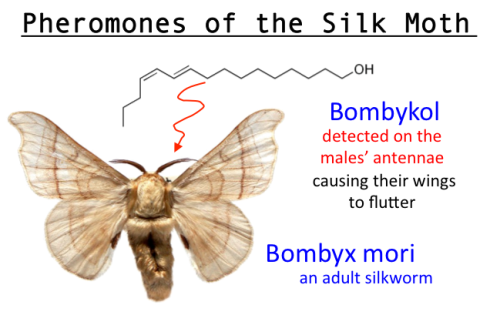A chemical substance produced and then released into environment by an animal (Mammal or an ants) which affects the behaviour and physiology of others of same species.
Pheromones are first identified in 1959 .Gustav Jager was the first to propose the idea of pheromones. He called them anthropines.
Main goal -
Communicate with other members of its own species .
Insect pheromones -(Ants and honeybess )
Insects have an alarm pheromone to attract other insects of same species during emergency.Once the period is over the insects return quietly to their former occupations .
Mammal pheromones -(Dogs and Cats )
Many mammals deposit chemicals in and around, as these vaporize they signal to the other member of the same species.
Domestic rabbit mothers release a mammary pheromone that triggers immediate nursing behaviour by their babies. Humans may have pheromones .
Characteristics of pheromones-

Image source credit -http://24.media.tumblr.com/tumblr_l7xo7jsjKj1qbtjkwo1_500.png
Q1.Which of the following is not a function of pheromones?
b. used for animal communication
c. Messenger RNA
d. Always protein
B.male moths
C.caterpillar
D.female bugs
Pheromones are first identified in 1959 .Gustav Jager was the first to propose the idea of pheromones. He called them anthropines.
Main goal -
Communicate with other members of its own species .
Insect pheromones -(Ants and honeybess )
Insects have an alarm pheromone to attract other insects of same species during emergency.Once the period is over the insects return quietly to their former occupations .
Mammal pheromones -(Dogs and Cats )
Many mammals deposit chemicals in and around, as these vaporize they signal to the other member of the same species.
Domestic rabbit mothers release a mammary pheromone that triggers immediate nursing behaviour by their babies. Humans may have pheromones .
Characteristics of pheromones-
- It is similar to hormones but work outside of the body .
- It induce activity in other individual of same species.
- Virtually all insects use pheromones to communicate .
- It is a exocrine secretion .

Image source credit -http://24.media.tumblr.com/tumblr_l7xo7jsjKj1qbtjkwo1_500.png
Types of pheromones insect produce -
- Sex pheromone - It brings together opposite sexes for mating.
- Aggregation pheromone- Attracts both sexes generally for feeding on food source or for mating.
- Alarm pheromone- Alerts other individuals to some source of danger .
- Trail pheromone- It marks a trail laid by pioneering individuals towards a source of food or refuge .Other individuals follow it to reach the source .
- Social pheromone - It governs interaction among organized societies .
Types of pheromone-
There are four principal kinds of pheromones:
- Releaser pheromones - they elicit an immediate response, the response is rapid and reliable. They are usually linked to sexual attraction.
- Primer pheromones - these take longer to get a response. They can, for example, influence the development or reproduction physiology, including menstrual cycles in females, puberty, and the success or failure of pregnancy. They can alter hormone levels. In some mammals, scientists found that females who had become pregnant and were exposed to primer pheromones from another male, could spontaneously abort the fetus.
- Signaler pheromones - these provide information. They may help the mother to recognize her newborn by scent (fathers cannot usually do this). Signaler pheromones give out our genetic odor print.
- Modulator pheromones - they can either alter or synchronize bodily functions. Usually found in sweat. In animal experiments, scientists found that when placed on the upper lip of females, they became less tense and more relaxed. Modulator hormones may also affect a female's monthly cycle.
Functions-
1.Pheromone products for women contain ovulation pheromone, which make them more attractive, obtainable, and profitable.
2.Pheromone products for men contain the alpha-male pheromone, which make them more sexually aggressive.
3.Monitoring of insect pests .
A)sex attractants
B)trigger alarm behaviors
C)trail markers
D)All of these are functions of pheromones.
B)trigger alarm behaviors
C)trail markers
D)All of these are functions of pheromones.
Ans . D.
Q2 .Q. The chemical, which attracts opposite sex insects of a species, is known as -
1) Hormones
2) Allomones
3) Kairomones
4) Pheromones
1) Hormones
2) Allomones
3) Kairomones
4) Pheromones
Ans. 4
Q3.Pheromone is-
a. a product of endocrine glandb. used for animal communication
c. Messenger RNA
d. Always protein
Ans. b
Q.4 'Pheromones trap 'attracts -
A.female moths B.male moths
C.caterpillar
D.female bugs
Ans. b
Thank you for visiting my blog.Please feel free to share your comment on this
article ,Please subscribe and share the articles to get more such articles.
article ,Please subscribe and share the articles to get more such articles.

No comments:
Post a Comment